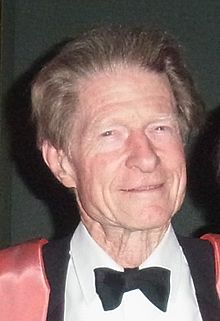John Gurdon
Sir John Bertrand Gurdon (JBG) FRS (born 2 October 1933) is a British developmental biologist. He is best known for his pioneering research in nuclear transplantation,[2][3][4] and cloning.[1][5][6][7]
John Bertrand Gurdon | |
|---|---|
 | |
| Born | 2 October 1933 |
| Nationality | British |
| Alma mater | Christ Church, Oxford |
| Known for | Nuclear transfer, cloning |
| Awards | Wolf Prize in Medicine (1989) Albert Lasker Basic Medical Research Award (2009) Nobel Prize in Physiology or Medicine (2012) |
| Scientific career | |
| Fields | Developmental biology |
| Institutions | University of Oxford University of Cambridge California Institute of Technology |
| Thesis | Studies on nucleocytoplasmic relationships during differentiation in vertebrates (1961) |
| Doctoral advisor | Michael Fischberg[1] |
| Website | www www |
Nuclear transplantation means taking the nucleus out of cells in tissue culture and putting them into other cells whose nucleus has been removed. It is called somatic cell nuclear transfer. In this way, specialised cells can be "reprogrammed" to become like stem cells.
Honours and awards change
Gurdon was made a Fellow of the Royal Society in 1971, and was knighted in 1995. In 2004, the Wellcome Trust/Cancer Research UK Institute for Cell Biology and Cancer was renamed the Gurdon Institute in his honour.[8] He has also received numerous awards, medals and honorary degrees.[9] He has been awarded the 2009 Albert Lasker Basic Medical Research award.
Nobel Prize change
In 2012 Gurdon was awarded, jointly with Shinya Yamanaka, the Nobel Prize in Physiology or Medicine "for the discovery that mature cells can be reprogrammed to become pluripotent".[10] "Pluripotent" cells are stem cells.
Research change
Nuclear transfer change
In 1958, Gurdon, then at the University of Oxford, successfully cloned a frog using intact nuclei from the somatic cells of a Xenopus tadpole.[11][12] This was an important extension of work of Briggs and King in 1952 on transplanting nuclei from embryonic blastula cells.[13]
Gurdon’s experiments captured the attention of the scientific community and the tools and techniques he developed for nuclear transfer are still used today.
At that time he could not conclusively show that the transplanted nuclei derived from a fully differentiated cell. This was finally shown in 1975 by a group working at the Basel Institute for Immunology in Switzerland.[14] They transplanted a nucleus from an antibody-producing lymphocyte (proof that it was fully differentiated) into an enucleated egg and got living tadpoles.
Gurdon’s experiments captured the attention of the scientific community and the tools and techniques he developed for nuclear transfer are still used today. The term 'clone' (from the ancient Greek word κλών klōn = “twig”) was already in use since the beginning of the 20th century in reference to plants.[15] In 1963 the British biologist J.B.S. Haldane, in describing Gurdon’s results, became one of the first to use the word "clone" in reference to animals.
He was awarded the Lasker Award in 2009 and the Nobel Prize in Physiology or Medicine in 2012.[16]
Messenger RNA expression change
Gurdon and colleagues also pioneered the use of Xenopus eggs to translate microinjected messenger RNA molecules.[17] This technique has been widely used to identify the proteins encoded, and to study their function.
Recent research change
Gurdon's recent research has focused on analysing intercellular signalling factors involved in cell differentiation, and on elucidating the mechanisms involved in reprogramming the nucleus in transplantation experiments, including demethylation of the transplanted DNA.[18]
References change
- ↑ 1.0 1.1 Williams R. 2008. Sir John Gurdon: Godfather of cloning. The Journal of Cell Biology 181 (2): 178–179. [1]
- ↑ Gurdon J. & Byrne J.A. 2003. The first half-century of nuclear transplantation. Proceedings of the National Academy of Sciences 100 (14): 8048. [2] Archived 2016-05-18 at the Wayback Machine
- ↑ Gurdon J.B. 2006. From nuclear transfer to nuclear reprogramming: the reversal of cell differentiation. Annual Review of Cell and Developmental Biology 22: 1–22. [3] Archived 2020-01-05 at the Wayback Machine
- ↑ Gurdon J.B. & Melton D.A. 2008. Nuclear reprogramming in cells. Science 322 (5909): 1811–1815. [4]
- ↑ Kain K. 2009. The birth of cloning: An interview with John Gurdon. Disease Models and Mechanisms 2 (1–2): 9–10. [5]
- ↑ Gurdon J. 2003. John Gurdon. Current biology : CB 13 (19): R759–R760. [6]
- ↑ Gurdon J. 2000. Not a total waste of time: an interview with John Gurdon. Interview by James C Smith. The International journal of developmental biology 44 (1): 93–99.[7]
- ↑ "The Gurdon Institute". Retrieved 2011-07-26.
- ↑ Rodney Porter Lectures: Biography
- ↑ "The Nobel Prize in Physiology or Medicine 2012". NobelPrize.org. October 8, 2012. Retrieved October 8, 2012.
- ↑ Gurdon J.B; Elsdale T.R. & Fischberg M. 1958. Sexually mature individuals of Xenopus laevis from the transplantation of single somatic nuclei. Nature 182 (4627): 64–65. [8]
- ↑ Gurdon J.B. 1962. The developmental capacity of nuclei taken from intestinal epithelium cells of feeding tadpoles. Journal of embryology and experimental morphology 10: 622–640. [9]
- ↑ Robert Briggs and Thomas J. King 1952. Transplantation of living nuclei from blastula cells into enucleated frogs' eggs. Proc Natl Acad Sci U S A. 38 (5): 455–463. [10]
- ↑ "Lymphocytes of the toad Xenopus laevis have the gene set for promoting tadpole development". Science. 190 (4221): 1310–1312. 1975. Bibcode:1975Sci...190.1310W. doi:10.1126/science.1198115. PMID 1198115. S2CID 23153308.
{{cite journal}}: Cite uses deprecated parameter|authors=(help) - ↑ Gurdon, J.B.; Colman, A. (1999). "The future of cloning". Nature. 402 (6763): 743–746. Bibcode:1999Natur.402..743G. doi:10.1038/45429. PMID 10617195. S2CID 4302017.
- ↑ "The Nobel Prize in Physiology or Medicine - 2012 Press Release". Nobel Media AB. 2012-10-08.
- ↑ Gurdon J.B. et al 1971. Use of frog eggs for the study of messenger RNA and its translation in living cells. Nature 233 (5316): 177–182. [11]
- ↑ Simonsson S. & Gurdon J. 2004. DNA demethylation is necessary for the epigenetic reprogramming of somatic cell nuclei. Nature Cell Biology 6 (10): 984–990. [12]